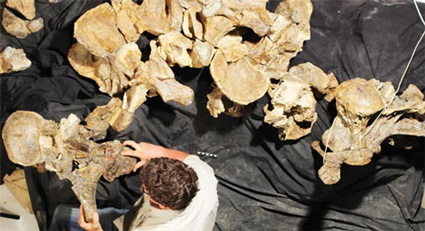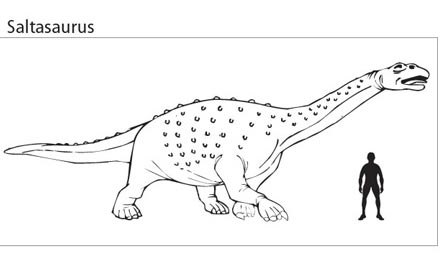Working on a Titanosaur – It’s a Colossal Job!
The number of huge titanosaurs (long-necked dinosaurs), known from Australia is likely to dramatically increase over the next few years as palaeontologists get to grips with the huge amount of dinosaur fossil material that is currently being studied, most of which originates from Australia’s unofficial dinosaur capital, Winton (Queensland). Although, only a handful of titanosaurs have been named and described to date, scientists studying fossils excavated over the last ten years or so are confident that many more sauropods will soon be added to the list of dinosaurs known from down-under.
“Wade” the Aussie Dinosaur
Palaeontologist Stephen Poropat, (Uppsala University, Sweden) presented a paper detailing the research work last week in Adelaide, at the fourteenth biennial Conference of Australasian Vertebrate Evolution, Palaeontology and Systematics. He commented on the discovery of the pelvis and dorsal vertebrae of a new titanosaur, one of the most complete large dinosaur fossil founds ever made in north-eastern Australia.
The palaeontologist stated:
“There have been about seventeen dinosaurs named from Australia, many of them are just represented by single bones. But with this one, all of the vertebrae are very close, sitting just in front of the pelvis. It’s definitely one animal.”
From Winton in Queensland
This dinosaur has been given the nickname of “Wade” and so many fossils have been found in the Winton area of Queensland the field workers have a very difficult jog of mapping sites and keeping up with all the developments, as reported by Everything Dinosaur in 2008.
To read the article: Trying to Keep Up with Aussie Dinosaur Excavations.
The titanosaur known as Wade was first excavated back in 2005 by a joint team of scientists from the Australian Age of Dinosaurs Museum (Winton) and the Queensland Museum. The size and delicate nature of the fossil material has meant that it has taken eight years to get the fossils fully prepared and restored. Wade has some unique features for a titanosaur. Titanosaurs generally leave wider tracks than those of equivalent sized diplodocids, but Wade has extremely wide hips, even for a titanosaur so this suggests a big animal with massive proportions, resulting in much wider track ways – were any trace fossils of this nature to be discovered.
The first metacarpal bone (part of the thumb) of this dinosaur is much more robust when compared to other titanosaurs. This supports the hypothesis that Wade was an enormous dinosaur, the enlarged thumb would have helped to support the animal’s great weight as it slowly crossed its Cretaceous homeland.
With the bones having been prepared, Stephen and his team can begin the job of comparing this specimen with the fossilised bones of already named and described titanosaurs to try to establish anatomical relationships.
Stephen commented:
“What I’m doing is looking at new and old specimens, trying to get a good idea of how the fauna changes over time.”
A spokesperson from Everything Dinosaur stated:
“The substantial amount of fossil material found in this single location may well represent a single individual, this permits scientists the opportunity to learn so much more about this dinosaur, when compared to just having individual bones to study.”
Diamantinasaurus and Wintonotitan
Two already described titanosaurs, Diamantinasaurus (nicknamed Matilda), Wintonotitan (nicknamed Clancy) and “Wade” all existed at around the same time and in the same area indicating a rich and verdant environment. Certainly, the ecosystem would have had to be exceptionally rich to sustain such a range of giant herbivores.
Examining the Vertebrae – Getting to Grips with Titanosaurs
Picture credit: (Credit: Judy Elliott/Australian Age of Dinosaurs Museum)
Postdoctoral Research Fellow, Stephen Poropat examining the titanosaur fossil bones.
The scientists are also hoping to explore the phylogenetic relationships between the Australian titanosaurs and their prehistoric counterparts for South America and Africa. Phylogeny is the study of evolutionary relationships between organisms. Wade may well shed new light on the evolutionary relationships of Gondwanaland’s biggest residents.
An Illustration of a Typical Titanosaur
Picture credit: Everything Dinosaur
For models and replicas of titanosaurs and other prehistoric animals: CollectA Prehistoric Life Models.







Leave A Comment